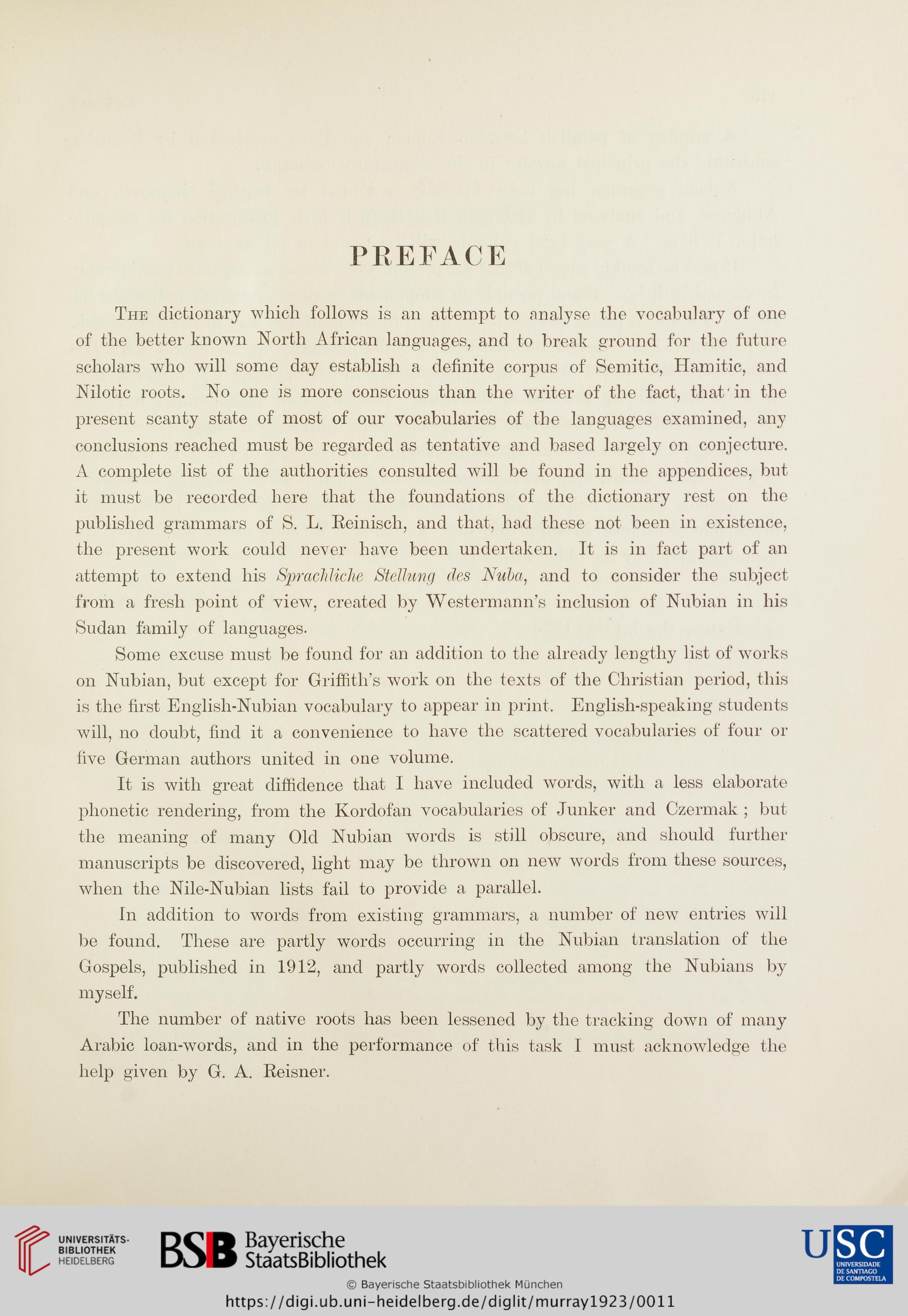PREFACE
The dictionary which follows is an attempt to analyse the vocabulary of one
of the better known North African languages, and to break ground for the future
scholars who will some day establish a definite corpus of Semitic, Hamitic, and
Nilotic roots. No one is more conscious than the writer of the fact, that 'in the
present scanty state of most of our vocabularies of the languages examined, any
conclusions reached must be regarded as tentative and based largely on conjecture.
A complete list of the authorities consulted will be found in the appendices, but
it must be recorded here that the foundations of the dictionary rest on the
published grammars of S. L. Reinisch, and that, had these not been in existence,
the present work could never have been undertaken. It is in fact part of an
attempt to extend his Sprachliche Stellung des Nuba, and to consider the subject
from a fresh point of view, created by Westermann’s inclusion of Nubian in his
Sudan family of languages.
Some excuse must be found for an addition to the already lengthy list of works
on Nubian, but except for Griffith’s work on the texts of the Christian period, this
is the first English-Nubian vocabulary to appear in print. English-speaking students
will, no doubt, find it a convenience to have the scattered vocabularies of four or
five German authors united in one volume.
It is with great diffidence that I have included words, with a less elaborate
phonetic rendering, from the Kordofan vocabularies of Junker and Czermak ; but
the meaning of many Old Nubian words is still obscure, and should further
manuscripts be discovered, light may be thrown on new words from these sources,
when the Nile-Nubian lists fail to provide a parallel.
In addition to words from existing grammars, a number of new entries will
be found. These are partly words occurring in the Nubian translation of the
Gospels, published in 1912, and partly words collected among the Nubians by
myself.
The number of native roots has been lessened by the tracking down of many
Arabic loan-words, and in the performance of this task I must acknowledge the
help given by G. A. Reisner.
The dictionary which follows is an attempt to analyse the vocabulary of one
of the better known North African languages, and to break ground for the future
scholars who will some day establish a definite corpus of Semitic, Hamitic, and
Nilotic roots. No one is more conscious than the writer of the fact, that 'in the
present scanty state of most of our vocabularies of the languages examined, any
conclusions reached must be regarded as tentative and based largely on conjecture.
A complete list of the authorities consulted will be found in the appendices, but
it must be recorded here that the foundations of the dictionary rest on the
published grammars of S. L. Reinisch, and that, had these not been in existence,
the present work could never have been undertaken. It is in fact part of an
attempt to extend his Sprachliche Stellung des Nuba, and to consider the subject
from a fresh point of view, created by Westermann’s inclusion of Nubian in his
Sudan family of languages.
Some excuse must be found for an addition to the already lengthy list of works
on Nubian, but except for Griffith’s work on the texts of the Christian period, this
is the first English-Nubian vocabulary to appear in print. English-speaking students
will, no doubt, find it a convenience to have the scattered vocabularies of four or
five German authors united in one volume.
It is with great diffidence that I have included words, with a less elaborate
phonetic rendering, from the Kordofan vocabularies of Junker and Czermak ; but
the meaning of many Old Nubian words is still obscure, and should further
manuscripts be discovered, light may be thrown on new words from these sources,
when the Nile-Nubian lists fail to provide a parallel.
In addition to words from existing grammars, a number of new entries will
be found. These are partly words occurring in the Nubian translation of the
Gospels, published in 1912, and partly words collected among the Nubians by
myself.
The number of native roots has been lessened by the tracking down of many
Arabic loan-words, and in the performance of this task I must acknowledge the
help given by G. A. Reisner.




